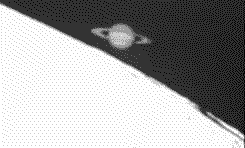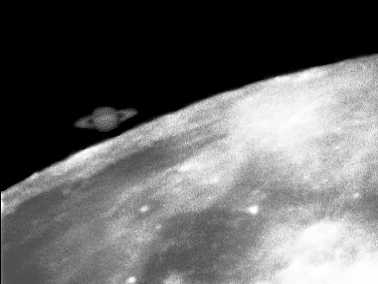
© 1997 Mortfield/Phelps
 © 1997 Mortfield/Phelps |
The Best Three Hours of My Astronomical Life1997 September 18 |
Wednesday, 1997 September 17 was a very indecisive day. A grazing occultation of Saturn by the Moon was scheduled for 3:30am Thursday but the weather was not cooperating. The forecasts (I checked dozens of them) were ambiguous as usual. The sky out my window kept changing from just OK to very much not OK. My astro friends on the Net were doing the same thing; much ambiguous email was exchanged. At 10pm the others gave up but I held out for a final decision at midnight. As Thursday approached, one last peek outside showed the Moon and Saturn as clearly as can be expected in the middle of a sea-level city but low clouds were closing in fast. One last peek at the weather satellite images showed a hole in the upper level clouds over us. I decided to go for it. I sure wasn't going to see anything if I went to bed :-) It was probably the best decision I've made since I bought my first telescope.
So into my Mitsubishi 3000GT went my 12 inch Meade LX200, tripod and accessories (that such a thing is possible is another story). I sent one last ambiguous email and was on the road just two minutes into Thursday. My destination was Henry Coe State Park (37 22 N, 121 30 W), a few miles south of my home in San Jose, CA. At that location, Saturn was predicted to just graze the edge of the Moon's limb; at home in San Jose it was to be a near miss while at our usual spot at Fremont Peak a little farther south a total occultation was expected. And, unlike the weather forecasts, astronomical predictions are extremely trustworthy. Coe was the place to be.
Fortunately, there wasn't much traffic since I was looking at the sky half the time instead of the road. Curiously, I wasn't too anxious. I figured the worst that could happen was that I would have a nice moonlight drive up the mountain and back down. In the valley there were low broken clouds illuminated from below by the orange city lights and from above by the blue moonlight. I thought it was actually kind of pretty, especially since I expected to leave them behind as I got up the mountain. That turned out to be correct but the hole in the upper level clouds turned out to be smaller than I expected and by the time I was out from under the low crud the Moon was playing hide and seek with the high clouds. That, too, made for a pretty but somewhat more worrisome sight. Driving up the winding mountain road with my eyes on the sky most of the time was not an example for the driving schools. The 3000GT was bored. But the sky was improving! By the time I arrived at the top there were BIG holes.
As I drove into the campground with only my parking lights on, I was greeted by a small red light waving around. That could only be another astronomer. Had my last email gotten thru in time? No, the owner of the red light was William Phelps who also turned out to own a 7 inch f/9 Astrophysics refractor. I was glad to have some company since the main event was still two and a half hours away. As it turned out, I was to be VERY glad...
William was encouraging about the weather. His opinion was that the edge of the cloud band was approaching and that we had a good chance of clear weather for the graze. So we both set up our scopes to let them get cooled down well in advance. (Fortunately, it was a pretty warm night, anyway. I made do with only a sweatshirt.) The Moon was still going in and out of the holes. But it and Saturn were visible even through the clouds. Maybe we need not worry so much about them after all? Then as we were just waiting around, casual glances at Saturn looked pretty sharp, Cassini's division was easy even with all the bad weather. That got our attention. In fact the seeing was excellent, one of the best nights all year! Of course, the transparency was horrible; but this was of no consequence for viewing the Moon and Saturn.
The Moon was almost two days past full so there were lots of features visible along the terminator on the (selenographic) eastern limb. I was able to use 350x with no problems. My eye was first drawn to a broad linear feature which may have been Vallis Snellius. The rimae and central mountains in Petavius were excellent. But this was just foreplay...
Soon after William and I set up Paul Mortfield showed up. He and William were planning to make a video of the graze. They had an expensive "prosumer" video camera whose lens was removable and could be attached directly to the big refractor. They also had a small color monitor on which to watch the show. After what I thought was an amazingly small amount of fussing they had it up and running. Wow! Live video of the Moon! And Saturn. We could see Cassini's division and banding in the southern hemisphere on the monitor! The resulting tape will be pretty interesting (part of it was aired on KPIX-TV Channel 5, San Francisco). The animated gif above was made from a few frames of it by Rick Baldridge of PAS.
It turned out that William not only owns a top of the line AP refractor but also a Zeiss/AP binoviewer. I had had poor experiences with similar units before; I was never able to get the images to fuse. Seeing double is no fun at all, it gives me a headache in just a few seconds. So I was eager to try another example of this reputedly fabulous (and fabulously expensive) gadget. A quick peek thru William's refractor showed that I really could fuse the images. And it looked pretty nice on Saturn. Damned nice in fact. I hesitantly asked if I could try it on my LX200 so I could relax and take my time to evaluate it on my own scope. William generously agreed. In a few seconds I had my diagonal off and the binoviewer installed (along with a pair of 19mm Televue Panoptics). Looking at the Moon my eyes fused the image instantly. Wow! WOW!! OH WOWIE ZOWIE!!! Eyegasm! At last I knew what it's all about. All the things you've heard about these things is absolutely true. The view IS 3-D; it IS easier on the eye, much better than an eyepatch, MUCH better than squinting; the loss of light thru all the extra optics IS NOT a problem (at least with as 12" scope looking at the Moon or planets). Slewing the scope around the Moon was like flying, an unbelievable experience. The usually boring bright areas away from the terminator were full of interesting albedo features and wonderful details. Amazing! I later tried Paul's identical and equally excellent unit. I am totally sold. Unfortunately, I understand that this particular unit is no longer in production and that the cheaper ones are not as good. I not so briefly considered grand larceny. Wow!
(Note: I managed to acquire one about a month later; see my report of Oct 18.)
What's better than an eyegasm? A second eyegasm! The night's main event was now quickly approaching...
At first it was merely odd to see Saturn and the Moon in the same low power field. I had expected the contrast difference to be a major problem with the Moon's brilliance blowing away Saturn's delicate form. I had variously heard that Saturn would be 8 f/stops or 72 times dimmer; either way it's a lot. And so it was with Paul's video. When the exposure was set correctly for the Moon Saturn was a pale ghost of itself; when set for Saturn the Moon was a bright featurless disk. But the human eye is a wonderful device. Direct viewing showed both objects with no problems. I had also expected that the glare from the Moon would be a problem. But the extremely poor transparancy conditions made for very poor contrast between Saturn and the sky anyway. So we were not bothered by the Moon's glare. In my 12" I was able to see Rhea, Titan and Tethys, too; though only Titan was visible in the big refractors. In fact, I was able to see Titan when it appeared equally distant from both Saturn and the Moon (roughly an arcminute). I certainly did not expect that. We must have been living right, the sky gods were smiling on us that night.
As the Moon approached Saturn their relative motion became quite evident. With the binoviewer and the 19mm Panoptics I could see only a small portion of the Moon's limb along with Saturn. And then my brain flipped so that it seemed that it was Saturn that was moving against the stationary Moon. Of course, in reality the Moon's motion is far faster. But Saturn looks very small beside the huge Moon; one's brain expects the small thing to be the one in motion.
As Saturn dropped down onto the Moon's bright limb it was a surreal scene. Of course, both objects are very familiar but none of us had ever seen them together. Saturn looked so tiny and fragile against the looming edge of the Moon. And Saturn's pale yellow color was in marked contrast the the Moon's harsh bluish gray. The seeing was still holding up. We could still see Cassini's division as it slipped behind the Moon's limb.
As this was a grazing occultation, Saturn slipped along the limb of the Moon; it never disappeared entirely. It was easy to see it move against the lunar features. As it crossed the pole over to the dark limb a bit of blackness intruded between the terminator and Saturn. Then as Saturn rose again we first saw the whole of Saturn's disk, then the inner part of the occulted half of the ring, then Cassini's division and then it was over.
What a trip! Of course, we had all seen simulations and knew pretty much what to expect. But to actually witness it was awesome. We were all so excited that we were laughing and yelling at each other like a bunch of school kids. I had thought this would be interesting. But I had no idea what an emotional impact it would have! I will remember this night as long as I live.
Fog started to roll in shortly after the event. We all tore down quickly. As I was driving home (slowly, at 4am) I couldn't help thinking how close I had come to missing this wonderful night. Many is the time I've decided to stay home for fear of going to a lot of bother for nothing. And I thought too, of my friends and all those millions of ordinary folks asleep in their beds while this marvelous spectacle went on over their heads. How fortunate I was to be one of the lucky few to witness it. This was definitely the best three hours of my astronomical life.

(Image courtesy Adriano DeFreitas)